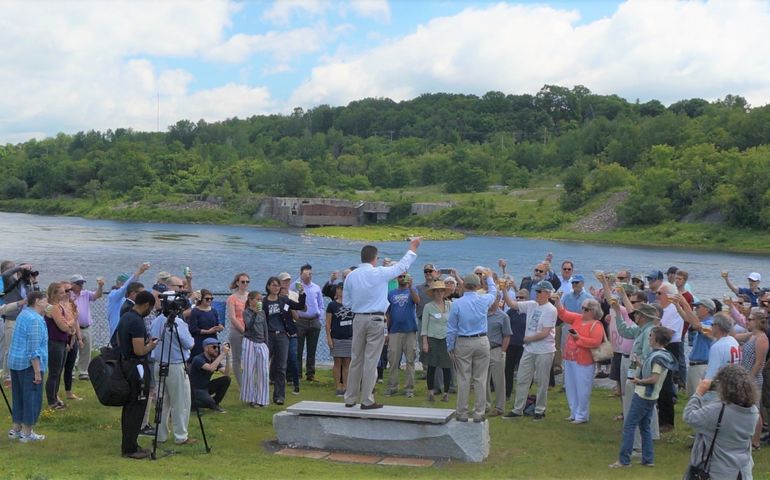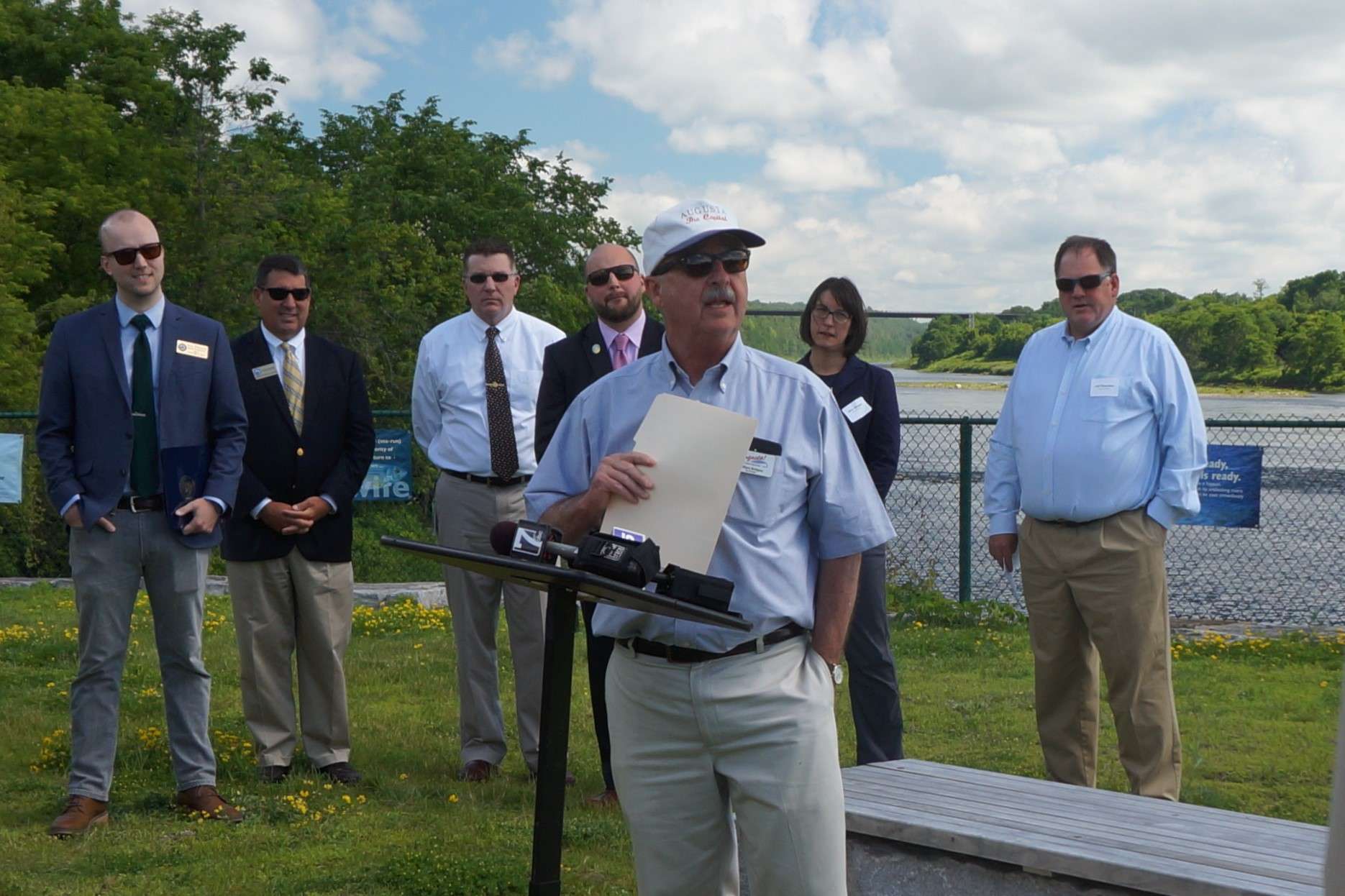
Edwards Dam removal unleashed 20 years of renewal, development
 Photo / Maureen Milliken
Patrick Keliher, commissioner of the Maine Department of Marine Resources, (on bench, white shirt) and Pete Didisheim, blue shirt, lead a toast to the Kennebec River at Monday's celebration of the 20th anniversary of the removal of the Edwards Dam in Augusta.
Photo / Maureen Milliken
Patrick Keliher, commissioner of the Maine Department of Marine Resources, (on bench, white shirt) and Pete Didisheim, blue shirt, lead a toast to the Kennebec River at Monday's celebration of the 20th anniversary of the removal of the Edwards Dam in Augusta.
A crowd of about 100 gathered on the sunny banks of the Kennebec River in Augusta yesterday to celebrate the 20th anniversary of the removal of the Edwards Dam — an event that not only made history, but ushered in new life for the 170-mile long river and rivers across the country.
When a backhoe opened up the dam and let the Kennebec River surge through, it was the first time ever that the federal government ruled that the ecological value of a free-flowing river was greater than the economic value of the dam, Pete Didisheim, senior director of advocacy at the Natural Resources Council of Maine, said at the event.
“This was the dam removal that was heard around the world, grabbing headlines as far away as Japan and capturing imaginations everywhere about the potential benefits of removing dams that prevent fish from reaching critical habitat,” said Didisheim.
“Removing the Edwards Dam has been a huge win for the Kennebec, communities along the river, and the fish and wildlife that returned with a vengeance once a path was cleared to reach waters that were blocked for 160 years.”
"It changed how people look at dams," he said. "Sometimes, the fish win."
Removal of the 917-foot-long dam, which stretched across the river from the Edwards mill on the west side to the Statler Tissue mill on the east side, revitalized the river’s health, contributing to the return of more than 30 million alewife and a huge boost in the state’s bald eagle population, the NCRM said in a news release. It also sparked a movement for free-flowing rivers in the U.S. and around the world.
Since the Edwards Dam was removed, 1,199 dams have been removed in the U.S., said Amy Singler, director of River Restoration for American Rivers.
"When we get out of the way, when we remove these obstructions, [rivers] have the ability to heal themselves," Singler told those gathered. "Time and time and time again, we see fish come back and the wildlife come back with the fish."

River comeback domino effect
The environmental comeback of the river also led to a comeback for the city itself, said state Rep. Matt Pouliot, R-Augusta, who is also a real estate broker with an office downtown. He told the crowd that before the dam was removed, when he was in seventh grade, he and his father liked to fish on Kennebec, but never in Augusta. They went downriver.
"From a real estate standpoint, for over 100 years, the city of Augusta turned its back on the river," Pouliot said. Now, he said, people can sit in the basement tasting room of Cushnoc Brewing, which fronts on the river, and watch sturgeon leaping from the water. "Nobody 25 years ago would have dreamed of that," he said.
Scott Wilkinson, representing U.S. Sen. Angus King, I-Maine, said that the significance of the dam removal to river restoration nationwide "can't be overstated." King was governor when the dam was removed, and was one of several who rang a bell to start the demolition.
"It set an example for communities not only across the state, but across the country," Wilkinson said. He said it showed rivers can be an asset for more than manufacturing."
Jeff Reardon, of Trout Unlimited, said he remembered someone saying to him in 1996, "I wouldn't let my dog swim in that river."
"As you can see, it's a revived river," he said. Much more, he said than 20 years ago, and even greater than 35 or 40 years ago.
The project was the fist example in the U.S. of how dam removal provides broad-scale recreational and fisheries benefits to society," John Burrows, Director of New England Programs at the Atlantic Salmon Federation said in the news release. "Today, the lower Kennebec has some of the largest runs of river herring and American shad in the Northeast thanks to the hard work of conservationists and state and federal fisheries agencies back in the 1990s."
The NRCM announced at the celebration it will form a committee that will design and fund a display about the history of the dam in Mill Park, the site of the Edwards mill and Monday's celebration. It will highlight the significance and success of its removal. Money also will be raised to install viewing binoculars overlooking the spot where the dam once stood.
"Mill Park now includes a boat ramp, pavilion, farmers’ market, dog park and green space, but there is no permanent information about the Edwards Dam," the NRCM release said. The committee, which will be co-chaired by NRCM CEO Lisa Pohlmann and Pouliot, will be to have the display in place by next spring.

Decade of negotiation
Part of Monday's celebration focused on the decade of conflict, negotiation and, ultimately, collaboration that led to the removal.
While pushed for decades by environmental and fishing groups, most notably the Kennebec River Angler's Association, the battle began in earnest in 1989, when the Kennebec Coaltion was formed. The group, which included American Rivers, Atlantic Salmon Federation, Natural Resources Council of Maine and Trout Unlimited and its Kennebec Valley Chapter, was created to advocate for dam removal through the federal relicensing process.
In the meantime, a move was on the amp up the hydro-generating power of the dam.
When the by then vacant massive Edwards mill burned in 1989, and its remains removed, the hydro generation equipment at the site was rebuilt, and in 1991 Edwards applied for a 50-year license to expand capacity of the generator from 3.5 to 11.5 megawatts.
That same year, Gov. John McKernan called for dam removal, and the Legislature adopted a resolve calling for it as well.
In 1992, the city of Augusta became a co-licensee with Edwards Manufacturing Co., with a contract that provided 3% of gross revenues to the city. The next year, Edwards' license with the Federal Energy Regulatory Commission to operate the dam expired, but the dam continued to operate on annual permits pending action on the application.
Settlement negotiations sponsored by FERC failed, though, the FERC issued a new policy concluding it had the authority to deny an application for relicensing, as well as authority to order a dam removed at the dam owner’s expense.
Though Edwards and Augusta objected, the dam removal process had started, leading to July 1, 1999, when King, among others, rang the bell to start the backhoe that breached the dam, as more than 1,000 watched from the river's banks.
Augusta City Manager Bill Bridgeo was hired in 1998, and his first day on the job he, City Councilor Dick Dumont and Mayor John Bridge met with King on the negotiations.
He said Monday that, ultimately, the mayor and city council did what they thought was best for the community, and the river.
The river, a source of manufacturing for so long in the city made the decision a tough one. "What ended up happening, through cooperation and collaboration, was an historic agreement," he said.
That involved cooperation among conservationists, state agencies and public official that also led to Maine dam removals that included Fort Halifax Dam in Winslow in 2008 and two dams in the Penobscot River, the Great Works and Veazie, that, as part of the Penobscot River Restoration Project, restored more than 2,000 miles of habitat to sea-run fish, the NRCM said.
'What can be done'
Art Bell and Bill Gregory, both of Yarmouth, attended Monday's celebration. Bell held a sign advocating for the removal of two dams on the Royal River in Yarmouth.
"Seeing this today, it's a reminder of what can be done," Bell said.
Another theme of the anniversary is the continuing effort to remove dams across the country.
“The removal of Edwards Dam has created the best American shad fishery in New England, restored an annual run of more than four million river herring to the lower Kennebec River, and set the stage for salmon restoration on the Kennebec,” Reardon, of Trout Unlimited, said. “Twenty years later, it’s time to honor that precedent by getting sea-run fish past the other dams on the Kennebec.”
Burrows, of the Atlanitc Salmon Federation, said in the news release, "All of the Kennebec River above Waterville — a huge watershed area — remains broken and inaccessible to sea-run fish for spawning and rearing due to myriad dams and unnatural impoundments. The fate of endangered Atlantic salmon in Maine will be determined by decisions made about dams on the river over the next decade. We need to reduce the number of dams on the Kennebec to find a balance between economics, recreation, and fisheries values.”










1 Comments